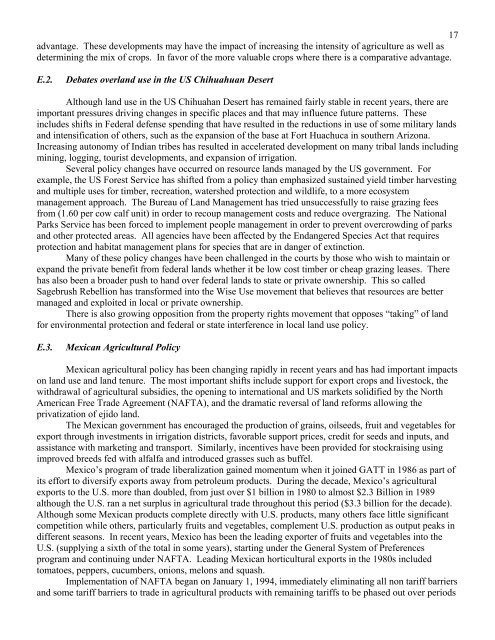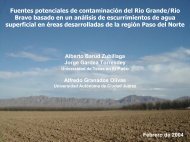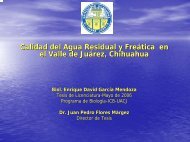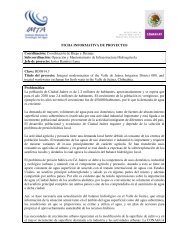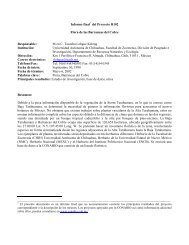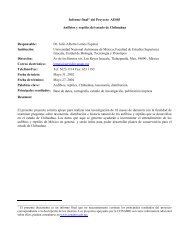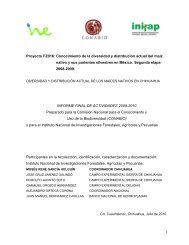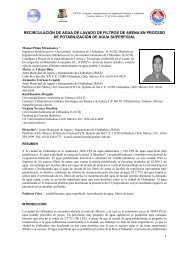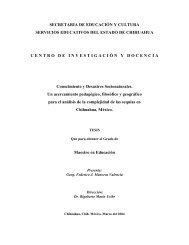land use and land tenure change in the - El Colegio de Chihuahua
land use and land tenure change in the - El Colegio de Chihuahua
land use and land tenure change in the - El Colegio de Chihuahua
You also want an ePaper? Increase the reach of your titles
YUMPU automatically turns print PDFs into web optimized ePapers that Google loves.
17advantage. These <strong>de</strong>velopments may have <strong>the</strong> impact of <strong>in</strong>creas<strong>in</strong>g <strong>the</strong> <strong>in</strong>tensity of agriculture as well as<strong>de</strong>term<strong>in</strong><strong>in</strong>g <strong>the</strong> mix of crops. In favor of <strong>the</strong> more valuable crops where <strong>the</strong>re is a comparative advantage.E.2.Debates over<strong>l<strong>and</strong></strong> <strong>use</strong> <strong>in</strong> <strong>the</strong> US <strong>Chihuahua</strong>n DesertAlthough <strong>l<strong>and</strong></strong> <strong>use</strong> <strong>in</strong> <strong>the</strong> US Chihuahan Desert has rema<strong>in</strong>ed fairly stable <strong>in</strong> recent years, <strong>the</strong>re areimportant pressures driv<strong>in</strong>g <strong>change</strong>s <strong>in</strong> specific places <strong>and</strong> that may <strong>in</strong>fluence future patterns. These<strong>in</strong>clu<strong>de</strong>s shifts <strong>in</strong> Fe<strong>de</strong>ral <strong>de</strong>fense spend<strong>in</strong>g that have resulted <strong>in</strong> <strong>the</strong> reductions <strong>in</strong> <strong>use</strong> of some military <strong>l<strong>and</strong></strong>s<strong>and</strong> <strong>in</strong>tensification of o<strong>the</strong>rs, such as <strong>the</strong> expansion of <strong>the</strong> base at Fort Huachuca <strong>in</strong> sou<strong>the</strong>rn Arizona.Increas<strong>in</strong>g autonomy of Indian tribes has resulted <strong>in</strong> accelerated <strong>de</strong>velopment on many tribal <strong>l<strong>and</strong></strong>s <strong>in</strong>clud<strong>in</strong>gm<strong>in</strong><strong>in</strong>g, logg<strong>in</strong>g, tourist <strong>de</strong>velopments, <strong>and</strong> expansion of irrigation.Several policy <strong>change</strong>s have occurred on resource <strong>l<strong>and</strong></strong>s managed by <strong>the</strong> US government. Forexample, <strong>the</strong> US Forest Service has shifted from a policy than emphasized susta<strong>in</strong>ed yield timber harvest<strong>in</strong>g<strong>and</strong> multiple <strong>use</strong>s for timber, recreation, watershed protection <strong>and</strong> wildlife, to a more ecosystemmanagement approach. The Bureau of L<strong>and</strong> Management has tried unsuccessfully to raise graz<strong>in</strong>g feesfrom (1.60 per cow calf unit) <strong>in</strong> or<strong>de</strong>r to recoup management costs <strong>and</strong> reduce overgraz<strong>in</strong>g. The NationalParks Service has been forced to implement people management <strong>in</strong> or<strong>de</strong>r to prevent overcrowd<strong>in</strong>g of parks<strong>and</strong> o<strong>the</strong>r protected areas. All agencies have been affected by <strong>the</strong> Endangered Species Act that requiresprotection <strong>and</strong> habitat management plans for species that are <strong>in</strong> danger of ext<strong>in</strong>ction.Many of <strong>the</strong>se policy <strong>change</strong>s have been challenged <strong>in</strong> <strong>the</strong> courts by those who wish to ma<strong>in</strong>ta<strong>in</strong> orexp<strong>and</strong> <strong>the</strong> private benefit from fe<strong>de</strong>ral <strong>l<strong>and</strong></strong>s whe<strong>the</strong>r it be low cost timber or cheap graz<strong>in</strong>g leases. Therehas also been a broa<strong>de</strong>r push to h<strong>and</strong> over fe<strong>de</strong>ral <strong>l<strong>and</strong></strong>s to state or private ownership. This so calledSagebrush Rebellion has transformed <strong>in</strong>to <strong>the</strong> Wise Use movement that believes that resources are bettermanaged <strong>and</strong> exploited <strong>in</strong> local or private ownership.There is also grow<strong>in</strong>g opposition from <strong>the</strong> property rights movement that opposes “tak<strong>in</strong>g” of <strong>l<strong>and</strong></strong>for environmental protection <strong>and</strong> fe<strong>de</strong>ral or state <strong>in</strong>terference <strong>in</strong> local <strong>l<strong>and</strong></strong> <strong>use</strong> policy.E.3.Mexican Agricultural PolicyMexican agricultural policy has been chang<strong>in</strong>g rapidly <strong>in</strong> recent years <strong>and</strong> has had important impactson <strong>l<strong>and</strong></strong> <strong>use</strong> <strong>and</strong> <strong>l<strong>and</strong></strong> <strong>tenure</strong>. The most important shifts <strong>in</strong>clu<strong>de</strong> support for export crops <strong>and</strong> livestock, <strong>the</strong>withdrawal of agricultural subsidies, <strong>the</strong> open<strong>in</strong>g to <strong>in</strong>ternational <strong>and</strong> US markets solidified by <strong>the</strong> NorthAmerican Free Tra<strong>de</strong> Agreement (NAFTA), <strong>and</strong> <strong>the</strong> dramatic reversal of <strong>l<strong>and</strong></strong> reforms allow<strong>in</strong>g <strong>the</strong>privatization of ejido <strong>l<strong>and</strong></strong>.The Mexican government has encouraged <strong>the</strong> production of gra<strong>in</strong>s, oilseeds, fruit <strong>and</strong> vegetables forexport through <strong>in</strong>vestments <strong>in</strong> irrigation districts, favorable support prices, credit for seeds <strong>and</strong> <strong>in</strong>puts, <strong>and</strong>assistance with market<strong>in</strong>g <strong>and</strong> transport. Similarly, <strong>in</strong>centives have been provi<strong>de</strong>d for stockrais<strong>in</strong>g us<strong>in</strong>gimproved breeds fed with alfalfa <strong>and</strong> <strong>in</strong>troduced grasses such as buffel.Mexico’s program of tra<strong>de</strong> liberalization ga<strong>in</strong>ed momentum when it jo<strong>in</strong>ed GATT <strong>in</strong> 1986 as part ofits effort to diversify exports away from petroleum products. Dur<strong>in</strong>g <strong>the</strong> <strong>de</strong>ca<strong>de</strong>, Mexico’s agriculturalexports to <strong>the</strong> U.S. more than doubled, from just over $1 billion <strong>in</strong> 1980 to almost $2.3 Billion <strong>in</strong> 1989although <strong>the</strong> U.S. ran a net surplus <strong>in</strong> agricultural tra<strong>de</strong> throughout this period ($3.3 billion for <strong>the</strong> <strong>de</strong>ca<strong>de</strong>).Although some Mexican products complete directly with U.S. products, many o<strong>the</strong>rs face little significantcompetition while o<strong>the</strong>rs, particularly fruits <strong>and</strong> vegetables, complement U.S. production as output peaks <strong>in</strong>different seasons. In recent years, Mexico has been <strong>the</strong> lead<strong>in</strong>g exporter of fruits <strong>and</strong> vegetables <strong>in</strong>to <strong>the</strong>U.S. (supply<strong>in</strong>g a sixth of <strong>the</strong> total <strong>in</strong> some years), start<strong>in</strong>g un<strong>de</strong>r <strong>the</strong> General System of Preferencesprogram <strong>and</strong> cont<strong>in</strong>u<strong>in</strong>g un<strong>de</strong>r NAFTA. Lead<strong>in</strong>g Mexican horticultural exports <strong>in</strong> <strong>the</strong> 1980s <strong>in</strong>clu<strong>de</strong>dtomatoes, peppers, cucumbers, onions, melons <strong>and</strong> squash.Implementation of NAFTA began on January 1, 1994, immediately elim<strong>in</strong>at<strong>in</strong>g all non tariff barriers<strong>and</strong> some tariff barriers to tra<strong>de</strong> <strong>in</strong> agricultural products with rema<strong>in</strong><strong>in</strong>g tariffs to be phased out over periods


